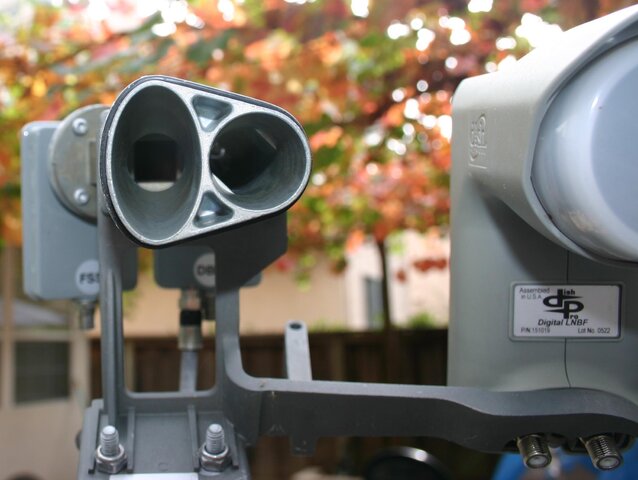A project I've been planning to do before winter, has finally happened. The goal: to modify a 121 SuperDish to receive G-18 FTA at 123 degrees instead of G-23 at 121, while keeping the 110 and 119 degree feeds original, for NASA, ect.
The Ku FSS feed is married to the 110 DBS feed at the manifold waveguide assembly. I divorced the pair [casting] with a hacksaw. To reconfigure, I rotated the front Ku feedhorn 180 degrees before reattaching to the manifold assembly, repositioned two degrees off center at an increased distance from the 110 & 119 DBS feeds. My photos illustrate how this feat was accomplished without additional hardware. Just some hacksawing, a couple freshly drilled screw holes on the flange, and a slight focal point readjustment by bending slightly inward on the Ku-FSS manifold lower support bracket. I plan on fabricating small covers of some sort to protect the open feedhorns when my testing is complete.
The results were as expected for a 36X20 inch dish. A slight loss of Ku efficiency from the stock configuration, due to having offset the Ku feed two degrees from optimum center. To avoid contributing to Ku efficiency loss on a marginal dish that already struggles with weaker transponders, I considered moving only the two DSS feeds, a more complex and time consuming procedure probably not worth the extra effort in the end. But since I have a pile of these dishes, I may give it a curious try, before winter.
Clear sky results at Eau Claire Wisconsin:
11720-V.... 55% Quality
11805-H.....65%
12114-V.... 60%
11800-V.....30% [A bit weak and borderline on a stock Superdish as it is.]
110 & 119.... most transponders are over 95%.






Below is my custom built signal level meter. As you can see, the enclosure is an old C-band LNBF, modified, using the original IF cascade amps and voltage regulator; added a second coax fitting, signal detector, potentiometer level control, analogue meter, plus a dual LED indicator to monitor 14/18 H/V voltage level switching and DiSEqC burst /22K activity. It works great. The sensitivity range is awesome.

The Ku FSS feed is married to the 110 DBS feed at the manifold waveguide assembly. I divorced the pair [casting] with a hacksaw. To reconfigure, I rotated the front Ku feedhorn 180 degrees before reattaching to the manifold assembly, repositioned two degrees off center at an increased distance from the 110 & 119 DBS feeds. My photos illustrate how this feat was accomplished without additional hardware. Just some hacksawing, a couple freshly drilled screw holes on the flange, and a slight focal point readjustment by bending slightly inward on the Ku-FSS manifold lower support bracket. I plan on fabricating small covers of some sort to protect the open feedhorns when my testing is complete.
The results were as expected for a 36X20 inch dish. A slight loss of Ku efficiency from the stock configuration, due to having offset the Ku feed two degrees from optimum center. To avoid contributing to Ku efficiency loss on a marginal dish that already struggles with weaker transponders, I considered moving only the two DSS feeds, a more complex and time consuming procedure probably not worth the extra effort in the end. But since I have a pile of these dishes, I may give it a curious try, before winter.
Clear sky results at Eau Claire Wisconsin:
11720-V.... 55% Quality
11805-H.....65%
12114-V.... 60%
11800-V.....30% [A bit weak and borderline on a stock Superdish as it is.]
110 & 119.... most transponders are over 95%.






Below is my custom built signal level meter. As you can see, the enclosure is an old C-band LNBF, modified, using the original IF cascade amps and voltage regulator; added a second coax fitting, signal detector, potentiometer level control, analogue meter, plus a dual LED indicator to monitor 14/18 H/V voltage level switching and DiSEqC burst /22K activity. It works great. The sensitivity range is awesome.




